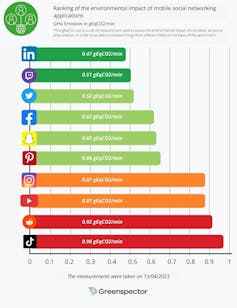
On a train or bus, or just standing in a queue, the most common sight these days is the muted glow of a screen, and the flickering thumbs of people lost in the endless scroll on their smartphones.
Across the world, about 62% of people are active social media users. In some countries, that figure is over 90%. That adds up to a lot of usage: the average UK adult spends 3 hours and 41 minutes online each day, which translates to around 56 days a year, almost two whole months.
Every time we read an article, see an advertisement, watch a photo or video, that content needs to be transferred from the social media platform’s servers to our device. The larger the file, the more data needs to be transferred. And high-resolution images or long videos involve lots of data.
That data is distributed across many “server farms” (typically housed in a large warehouse with thousands of computers) around the world. If you load a video from Youtube you don’t connect to a single “Youtube data HQ” somewhere in California, but will instead gather data from many different servers often in different countries or continents.
Moving data across the internet requires energy, sending signals through various electronic devices, including routers, servers, and our own mobile phone or laptop. Each of these devices consumes energy to function, while servers need to be kept cool. And this energy is often generated from fossil fuels.

Tiktok is the least eco-friendly of the social media platforms, according to a study of internet users in France run by Greenspector in 2021 and then updated in 2023.
Simply scrolling through the app exchanges a lot of data as Tiktok is constantly running videos, including many preloaded in the background that you may never even see.
At the end side of the spectrum is LinkedIn. As a text-based platform, with fewer photos and videos, scrolling through LinkedIn uses much less data.
Generative AI is energy-hungry
Social media is of course not the only offender. Generative AI, with its ability to create text, images, music and even videos, is completely reshaping lots of creative processes. But though it is appealing, and sometimes a necessity, it comes with an environmental price tag.
Unsurprisingly, the more powerful the AI, the more energy it consumes. Unlike when you stream video or load a large web page, with generative AI most energy is used at their end, while processing your query. If you ask ChatGPT to write you a novel, the process of writing involves lots of calculations, even if the resulting text itself doesn’t use much data.

All this of course raises critical questions about the sustainability of generative AI and about our own carbon footprints. The AI companies themselves are reluctant to tell us exactly how much energy they use, but they apparently can’t stop their own chatbots having a stab. I asked ChatGPT-4 “how much energy was used to process this query?” and it said “0.002 to 0.02 kWh”, which it said “would be similar to keeping a 60-watt bulb on for about 2 minutes”.
This roughly matches numbers offered by independent analysis and is tens of times more energy than required for a Google search. With millions of queries per day to ChatGPT alone, it all adds up to a huge amount of additional energy use. As generative AI continues to evolve, the demand for energy will only increase.
What you can do
While the environmental impact of these technologies raises valid concerns, it’s also essential to recognise their benefits. To take one example, AI-assisted tools like text-to-speech, voice recognition and auto-captioning have already made society more inclusive particularly for disabled or neurodiverse people. I don’t want to suggest we scrap social media or reject generative AI entirely.
But there are things we can do to reduce the carbon footprint of our internet use, involving a combination of individual actions and systemic changes. Here are some strategies we can all adopt:
First, limit the screen time. This is the most obvious one. Reducing the amount of time spent on social media can directly decrease energy consumption.
Second, use energy-saving settings on your devices, such as lowering screen brightness, using a dark background, and enabling power-saving modes.
Third, consider choosing less energy-demanding social media, using environmental ranking information to inform the decision. That means more text, and less video and generative AI.
Fourth, whenever possible, use wifi over 4G or 5G mobile data: wifi generally consumes less energy.
So, next time we find ourselves scrolling endless sequences of pictures and videos, our face lit by the blue glow of our screens, let’s just stop for a second and start implementing those simple strategies, so we can enjoy the benefits of being connected, while minimising the impact on our planet resources. Ultimately, the choice is ours.
Domenico Vicinanza does not work for, consult, own shares in or receive funding from any company or organisation that would benefit from this article, and has disclosed no relevant affiliations beyond their academic appointment.
This article was originally published on The Conversation. Read the original article.







